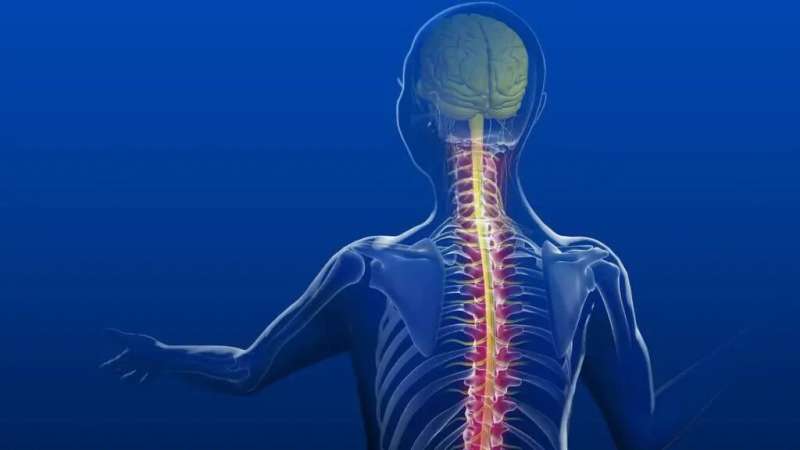This article has been reviewed according to Science X's editorial process and policies. Editors have highlighted the following attributes while ensuring the content's credibility:
fact-checked
trusted source
proofread
Pain in the back: Preventing and treating spinal arthritis

Many types of arthritis can affect your musculoskeletal system. Joints are physical points of connection between two bones, and cartilage is the tissue that covers the surface of the bone at the joint. A membrane, called the synovial membrane, lines the joint and is filled with fluid known as synovial fluid. All these components work together to make movement easy.
"Over time, the cartilage in joints can break down and cause swelling and tenderness," says Gazanfar Rahmathulla, M.B.B.S., M.D., a neurosurgeon at Mayo Clinic Health System in Eau Claire. "It's common in the joints used daily, such as the hands and knees. The spine comprises 33 bones stacked one over the other like Lego blocks, connected by three different joints. Arthritis can affect various joints in the body that are load-bearing and where movement occurs, including the spine."
Arthritis in the spine
The most common types of arthritis are osteoarthritis and rheumatoid arthritis. Osteoarthritis occurs when the cartilage that caps your bones wears away. Degenerative changes can happen over time in joints used daily for motion. Osteoarthritis is the most common type of arthritis.
Rheumatoid arthritis is caused when your body's immune system mistakenly attacks your joints. You may experience pain and swelling, and your bones and joints slowly erode and deform. You can get this type of arthritis at any age, but it is usually more common in adults 40 or older.
The spine is susceptible to osteoarthritis because of the motion between the vertebrae. It's most common in the lower back, or lumbar spine, because these joints carry most of the body weight. When a person stands upright, the lumber spine experiences additional strain and wears out faster than nonmobile levels, such as the middle of the spine.
The neck also is susceptible to arthritis. This is because of the millions of flexions, extensions and rotary movements made by the joints in the neck. Over time, the disk cartilages and facet joints tend to wear out.
Preventing spinal arthritis
There are several factors that can increase the risk of osteoarthritis. We can modify some of these risk factors, but the others are inherent and not modifiable. The factors that cannot be changed include a person's age, genetics, gender and ethnicity.
For risk factors that can be changed, the saying "an ounce of prevention is better than a pound of cure" applies to spinal arthritis. The modifiable risk factors include obesity, metabolic syndrome, previous injury, occupation, diet and physical activity. There are things that you can do to lower your risk of arthritis developing and causing painful symptoms, such as:
- Remain active. The more sedentary people are, the more likely they will have issues with arthritis pain. Strenuous physical activity isn't necessary. Simple exercises, like walking, help keep you mobile and your joints healthy.
- Maintain a healthy weight. Carrying extra weight is hard on the joints in your back. Aim for a healthy body weight to keep your joints happy.
- Don't use tobacco. People may understand that smoking affects lung health, but it also speeds up cartilage loss in joints and aggravates back pain. Don't start smoking, and if you do smoke, quit.
Treating spinal arthritis
Many people have some degree of degenerative changes in their spines due to arthritis. But not everybody who has arthritis on diagnostic imaging has symptoms. Treatment is only considered if a person is experiencing symptoms that don't go away with exercise or weight loss, and arthritis is present on images, such as an X-ray.
"It can be difficult to find the exact source of pain due to multiple joints, levels or nerves in the spine," Dr. Rahmathulla says. "Images, like an MRI scan or X-ray, help the health care team identify where the pain is coming from."
To develop an individualized treatment plan, the health care team will match the image results with the patient's reported symptoms. Any surgical procedure carries risk, so the goal is to medically manage arthritis symptoms without surgery in most cases. Conservative medical options for treating symptomatic spinal arthritis include physical therapy, chiropractic manipulation, exercise, massage, medications and weight loss. For most patients, these options lessen back pain and improve mobility.
Additional treatments may be necessary if symptoms aren't improving or the arthritis is causing compression of the nerves, leading to weakness or loss of mobility. Surgical options range from a laminectomy to a spinal fusion.
It's important to remember that nearly everyone will experience back pain at some time in their lives. Members of the health care team, including pain management, physical medicine and rehabilitation, primary care, physical therapy, and finally, the spine surgeon, carefully evaluate each patient and identify who may be a candidate for surgical intervention versus those who may not benefit from surgery and need to continue medical treatment options.
"It is essential that you talk with your health care team if you are struggling with ongoing back pain or pain and weakness that radiates down your legs or arms," Dr. Rahmathulla says.





















